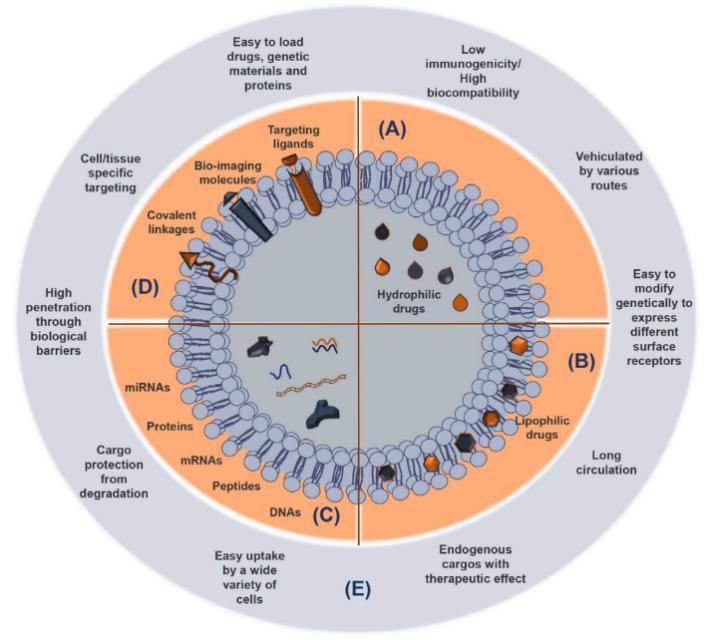Introduction to Current Exosome Administration Modes
Exosomes, as naturally secreted nanomedicine carriers, offer a new way of drug delivery due to their superior delivery stability and high modifiability compared to traditional nanomaterials. The delivery of exosomes requires a balance between good tissue penetration and reduced clearance by the blood. Creative Biolabs has accumulated many years of research experience in the modification and targeted delivery of exosomes in combination with their biological characteristics, and aims to provide high-quality exosome research services.
Advantages of Exosome Delivery
Exosomes are natural nanoscale membranous vesicles secreted by living cells and released extracellularly, with potential as nanoscale drug delivery vehicles. Exosomes are uniquely suited as liquid biopsy markers for disease diagnosis and as carriers for targeted drug delivery to improve drug efficacy as well as reduce side effects. Exosomes can optimize the efficiency of traditional drugs by encapsulating small molecule chemicals, and can also be targeted carriers for the delivery of protein-based and nucleic acid-based drugs, improving drug delivery efficiency, reducing drug frequency, combining drugs to enhance therapeutic efficacy, and reducing side effects from systemic exposure. There are many advantages of exosomes as promising next-generation revolutionary drug carriers.
-
The exosome-encapsulated drug is stable and long-lasting: The drug is encapsulated in stable exosomes, which can effectively reduce its contact with gastric acid, protein hydrolase, or nuclease, prolong the circulation time of the drug in the body, improve the efficiency of drug administration and reduce the frequency of drug administration.
-
Low immunogenicity and high delivery efficiency: exosomes are natural lipid membrane structures, which can load the drug to enter the target cells effectively without being recognized and cleared by the immune system.
-
Enhanced drug solubility and multiple drug co-delivery: The lipid bilayer hollow structure of exosomes is both lipophilic and hydrophilic, enabling effective loading of both lipid-soluble and water-soluble drugs while using genetic engineering to attach therapeutic bioactive molecules to the surface of exosomes.
-
Passive and active drug delivery with reduced side effects due to systemic exposure: Exosomes can not only cross large gaps of endothelial cells for passive targeting and long-term retention in tumor tissues but can also be engineered for active targeting.
 Fig.1 sEV cargoes and advantages as delivery systems of functional and therapeutic molecules. (Loch-Neckel, 2022)
Fig.1 sEV cargoes and advantages as delivery systems of functional and therapeutic molecules. (Loch-Neckel, 2022)
Multiple Modes of Exosome Administration
The high tissue permeability, high targeting, and ease of modification of exosomes compared to other vectors give them a higher potential for disease treatment. It is essential to take into account that the mode of exosome delivery has a strong link to the therapeutic efficacy of the delivered drug. Differences in the mode of drug delivery affect the pharmacokinetic profile of the drug, as well as its bioavailability and the speed of its efficacy. For the development of exosome delivery systems, the selection of the appropriate drug delivery method according to the nature of the drug and the therapeutic purpose can improve the therapeutic effect of the disease, as well as improve drug safety and patient compliance. The stable structure and high biocompatibility of exosomes allow them to be adapted to a variety of drug administration modes, including but not limited to:
The low immunogenicity and excellent biocompatibility of exosomes allow for greater flexibility in drug delivery, addressing to some extent the challenges and limitations of traditional nanomaterials in terms of drug delivery routes. Creative Biolabs has a long history of manufacturing exosomes and developing related targeted drug delivery systems, as well as providing custom exosome research services. Please contact us with your interest.
Reference
-
Loch-Neckel, G.; et al. Challenges in the development of drug delivery systems based on small extracellular vesicles for therapy of brain diseases. Front Pharmacol. 2022, 13: 839790.
For Research Use Only. Cannot be used by patients.
Related Services:

 Fig.1 sEV cargoes and advantages as delivery systems of functional and therapeutic molecules. (Loch-Neckel, 2022)
Fig.1 sEV cargoes and advantages as delivery systems of functional and therapeutic molecules. (Loch-Neckel, 2022)









